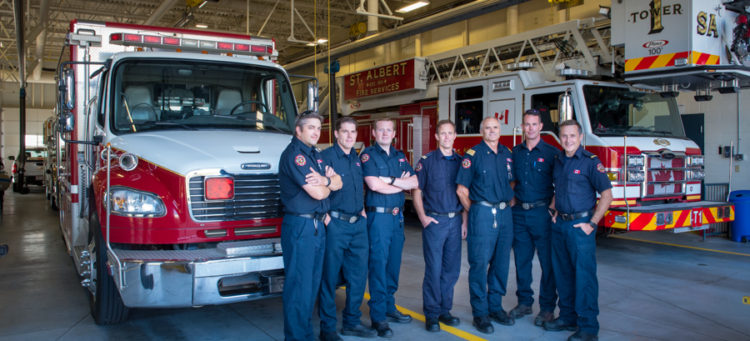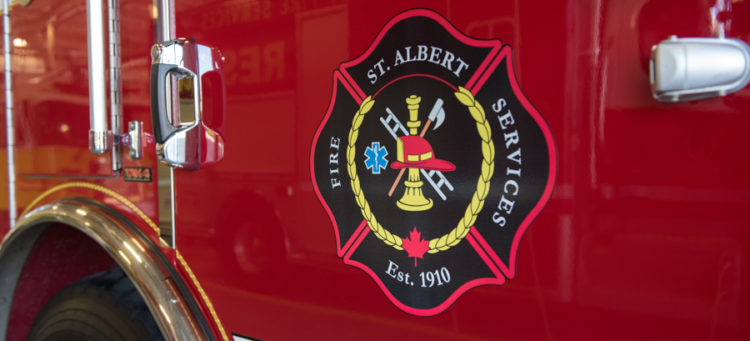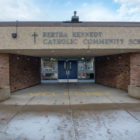Then & Now
St. Albert Fire and Rescue Services: From Stable to Station Exploring the 150-year legacy.
October, 2019
St. Albert has been a constantly growing community for over 150 years, and with it has grown its municipal services, such as fire and rescue. Established in the infancy of the 20th century as a volunteer brigade, St. Albert Fire and Rescue Services has since turned itself into a fully functional city department, helping transform St. Albert from a small town into one of Canada’s safest and most livable cities.
1910s-1940s
While founded in 1861, St. Albert did not establish its first fire brigade until 1910. The St. Albert Volunteer Fire Brigade initially consisted of roughly a dozen volunteers and a paid chief. With just two horse-drawn fire engines, the brigade operated out of a livery stable located half a block away from the St. Albert Hotel on the corner of Perron and St. Anne Street – the site where the Bruin Inn would eventually stand. In February 1912, The Edmonton Journal reported that the brigade had asked St. Albert’s town council for compensation in the amount of “a dollar a man per month, plus $25 a month for the chief.” Since the entire brigade at this time consisted solely of volunteers, routine fire drills were completed north of the town by extinguishing burning piles of wood in order to keep the men prepared for when a real blaze was to occur.
During this time, the brigade relied quite heavily on Edmonton Fire and Rescue Services, who had both more men, and more engines to combat fires. In September 1929, a conference was held in St. Albert for visiting Edmonton Fire Chief A. Dutton, who recommended changes regarding the town’s water supply in order to ensure that a reliable and convenient reserve was at all times available. Unfortunately, this suggestion made little difference as a string of high-profile fires including the St. Albert Covent fire of 1931, the Gillespie Grain fire of 1938, and the Hogan Residence fire of 1944 were all unable to be extinguished due to a lack of both water and manpower.
1950s-1970s
In 1959, the brigade appointed its very first full-time fire chief, Fred Tetarenko. A year later, the brigade received its first honour, the Certificate of Merit from the National Fire Protection Association for outstanding activities in the field of fire prevention in 1959. These outstanding activities included a first aid and fire prevention course taught to St. Albert Scouts and the observance of “Fire Prevention Week,” where the brigade would inspect homes and businesses for fire hazards.
In 1962, more good fortune came to the brigade in the form of $100,000 in city funding for the construction of Fire Station No. 1, which to this day still operates from 18 Sir Winston Churchill Avenue. But, cause for celebration soon diminished as it was reported by The Edmonton Journal that Tetarenko was deeply concerned with the state of his brigade. Out of 22 volunteer firefighters, 17 worked outside of St. Albert, making them unavailable to fight a fire during the day should one occur. And with a population of 8,000 in 1963, St. Albert was too small to afford a full-time fire department, and too large to continue depending entirely on a volunteer force.
A decade passed before a 1974 report was delivered to St. Albert’s town council by the provincial fire commissioner’s office which concluded that the community was in dire need of a force of 40 full-time firemen, new fire trucks, and, eventually, a large new central headquarters. This report stunned council members who would in turn pass a bylaw forming St. Albert’s first full-time fire department in 1975. Yet, controversy arose again in 1977 when $65,000 in funding was used to create the city’s first five-man ambulance division within the fire department even though it currently consisted of a mere 11 full-time firefighters, a fraction of the suggested 40 intended to serve a community of 24,000.
1980s-2000s
In 1980, the St. Albert Fire Department, along with firefighters from Edmonton and Morinville, fought and won a battle against one of St. Albert’s most expensive fires to date. Thought to be started by a cigarette left smoldering in a garbage bag, the St. Albert Inn fire caused roughly $3 million in damage and sent some 50 guests fleeing into the frigid February night air wearing nothing but their night clothes. It was the first time that a significant number of lives in St. Albert had been threatened by a single fire. This realization led to the construction of Fire Station No. 2 at 100 Boudreau Road which officially opened its doors in 1982.
By the 1990s, things were heating up for St. Albert Fire and Rescue Services. The city now had two fully functioning fire stations, a combined total of 56 firefighters and emergency medical technicians, and the lowest fire rate in the province. The only thing the city now lacked was a 9-1-1 service. But that changed in 1995 when the city, after three long years of discussions with Alberta Government Telephones (AGT), was finally connected to the emergency response service.
In 2009, the city’s third fire station opened at 100 Giroux Road as the new St. Albert Fire and Rescue Services headquarters. A great deal of attention was paid to the sustainable design and construction of the building, making it the first fire hall in Alberta, and the second in all of Canada to receive LEED (Leadership in Energy and Environmental Design) Gold Certification from the Canada Green Building Council.
2010-Today
Today, St. Albert Fire and Rescue Services employs a total of 112 firefighters, emergency medical technicians, and non-operational administrative staff dedicated to serving and protecting the 66,000 people who reside within the city. Moving forward, the burning question facing the city is what should be done about Fire Station No. 1? Since its construction more than 50 years ago, the building has been renovated three times, most recently in 2011. The city’s current plan is to relocate the hall to 20 Gate Avenue once St. Albert Transit moves to the new Campbell Road Park and Ride which is expected to be completed by September 2020















